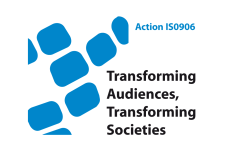- About the Action
- Events
- PhD workshop - Ljubljana 2014
- Action Open Conference - Ljubljana 2014
- New Media and Participation conference - Istanbul 2013
- Belgrade meeting 2013
- Media literacy research and policy - Brussels 2013
- ICA Pre-Conference 2013
- Tampere meeting 2013
- Budapest workshop 2012
- Milan meeting 2012
- Brussels PhD workshop 2012
- Brussels Action workshop 2012
- London meeting 2011
- Zagreb Conference 2011
- Lisbon meeting 2010
- Affiliated events
- WG 1
- WG 2
- WG 3
- WG 4
- Cross-WG
- Output
New ways of consumption: the audiences of public service media in Italy and Switzerland
Cola, M., Prario B (2012). New ways of consumption: the audiences of public service media in Italy and Switzerland. Media, Culture and Society, 34(2), 181-194.
Abstract: The digital transformation of the broadcasting industry forces public service broadcasting (PSB) companies to restructure and rethink their offerings. Characteristic today is a keener attention to the preferences and behaviours of audiences, and the importance of the link between the concept of public service and the role of audience participation. PSB companies are engaged in a reconsideration of their audiences. This article discusses the central role of the audience in the transformation from PSB to public service media (PSM), connecting (1) what has been done by PSM companies to grasp opportunities of digitalization to increase their offerings and (2) the public response to these strategies, analysing the consumption of PSM. The article considers two companies as cases: Rai in Italy, a large country and SRG SSR in Switzerland, a small country. Italy and Switzerland differ in the size and structure of their television markets. The market structure, the television distribution systems and the funding schema of the PSM companies analysed have influenced the development of strategies adopted by these companies and also audience responses. Empirical research is based on analysis of relevant policy documents, the case companies’ offerings, interviews with the firms’ operators, and audiences and users data.

